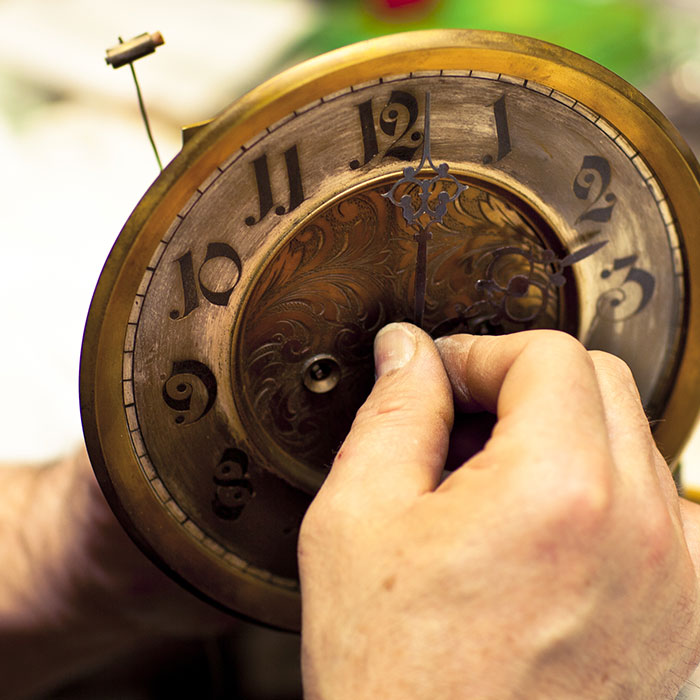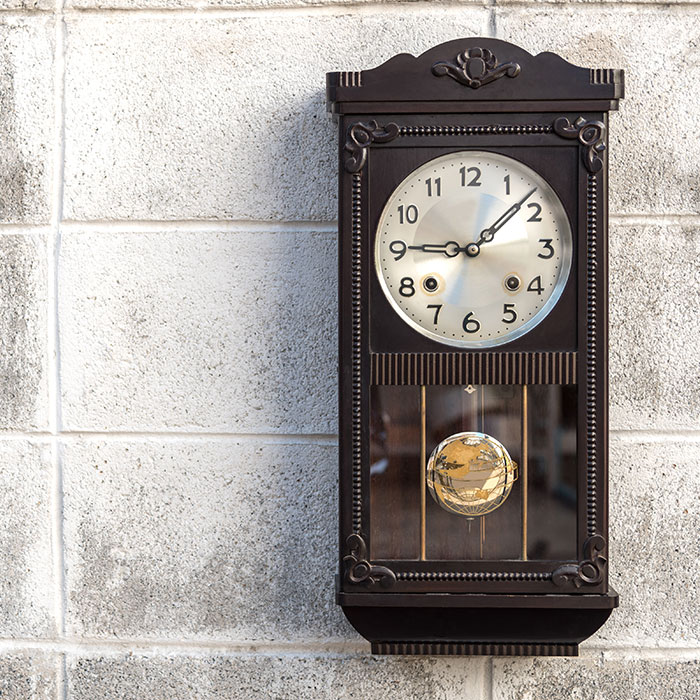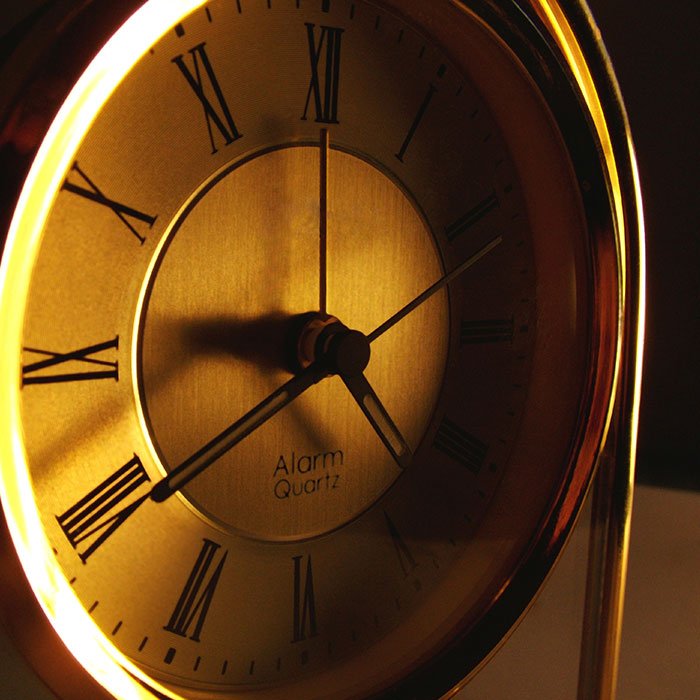Clock Instructions
We love helping people learn to care for their clocks and even teaching them how to fix simpler issues. If you have a chime clock or an American antique clock, check out our helpful tips below to learn about timekeeping accuracy, chime adjustments, pendulum setup, how to regulate the clock, and more.





Chime Clock Instructions
These instructions apply to many spring-driven quarter-hour chiming clocks.
Setup — Pendulum Mantel Clock:
Place clock on table with back facing you. Open the back door, hang the pendulum on the hook, and close the door. Carefully place the clock where it is to be used, on a stable, level surface. Lift one side of the clock gently two inches, then put it down to start the pendulum swinging.
Setup — Pendulum Shelf Clock:
Place the clock where it is to be used, on a stable, level surface. Open the front door and hang the pendulum on the hook (on many clocks the hook is behind the dial), give the pendulum a swing, and the clock will start ticking.
Setup — Pendulum Wall Clock:
Choose the proper size wood screw (typically a #8, 10 or 12) to fit the hanger at the top back of the clock, and long enough to go securely through the wall into a stud. Secure the screw into the wall, angled upward at a 45 degree angle, and hang the clock. Open the front door and hang the pendulum on the hook (on many clocks the hook is behind the dial), give the pendulum a swing, and the clock will start ticking. Move the bottom of the case to the left or right until ticking is even (or if there is a beat scale beneath the pendulum, move the case so the pendulum points to zero when at rest). Secure bottom of case to wall so clock is stable.
Setup — Balance Wheel Mantel Clock:
This type of clock usually starts by itself upon winding. If it does not, open the back door and start the balance wheel swinging by either of these two methods: 1) Quickly rotate the clock in the plane of the balance wheel to impart motion to it. 2) With a soft brush, rotate the balance wheel and release it.
Setting the Hands:
When setting the clock to time, move the minute hand clockwise, pausing at each quarter hour for the clock to chime.
Winding — Eight Day clock:
Wind the clock once per week, preferably on the same day each week. Turn the key with a smooth motion, stopping when the spring won’t wind any further. Never let the key snap back in your hand, always release it gently after each half-turn. Make sure the clock is fully wound, so keep turning the key until the spring won’t wind any further. The chime mainspring (usually the right hand winding square) will often take more force to wind than the other two springs.
Clocks with more than one chime melody:
Change the tune selector only when the clock is not chiming.
Timekeeping Accuracy:
This type of clock will be able to keep time within 3 – 7 minutes per week. You will need to do the final regulation once the clock is in its permanent location to achieve this accuracy. To check the clock’s accuracy, set the hands to the correct time, and then let the clock run at least 3 or 4 days. The main factors causing variations in rate are temperature changes, and the lessening tension of the mainspring as it runs down. Once the clock is regulated to keep good time, you will need to set the hands whenever the time is off by more than a few minutes — perhaps every week or two. Pendulum clock are usually more accurate than balance wheel clocks.
Regulating the clock — Regulating Square:
The clock can be made to go faster or slower by means of the small square on the dial. Turning it toward F speeds up the clock, and turning it toward S slows it down. The regulating square is turned with the small end of the winding key. Turn the square only a small amount each time.
Regulating the clock — Pendulum Nut:
The clock can be made to go faster or slower by means of the nut at the bottom of the pendulum. Turning the front of the nut to the right speeds up the clock, and turning it to the left slows it down (in other words move the nut up to speed up, or down to slow down). Turn the nut only a small amount each time.
Regulating the clock — Modern Balance Wheel:
The clock can be made to go faster or slower by means of the regulator, which is accessible by opening the back door. In this type of clock, the regulator is a screw near the balance wheel. With a small screwdriver, move the regulator in the direction needed (towards F for faster or towards S for slower). Move it only a small amount each time.
Regulating the clock — Balance Wheel with Pointer:
The clock can be made to go faster or slower by means of the regulator, which is accessible by opening the back door. In this type of clock, the regulator is a pointer behind the balance wheel. Push the pointer in the direction needed (towards F for faster or towards S for slower). Move it only a small amount each time.
Regulating the clock — Floating Balance:
The clock can be made to go faster or slower by means of the regulator, which is accessible by opening the back door. In this type of clock, the regulator is a pointer fastened to the balance wheel itself. Gently hold the balance wheel with two fingers, and move the regulator in the direction needed (towards F for faster or towards S for slower). Move it only a small amount each time.
ADJUSTMENTS
Chime Synchronization:
The vast majority of chime clocks have self-synchronizing chimes. If the chime sequence is wrong, it will correct it self within an hour to and hour and a half.
If Clock Strikes the Wrong Hour:
On most clocks, the hour hand is a friction fit on its shaft, and may be moved around to point to the hour that the clock struck.
Chime Sound Adjustment:
The hammers, which strike the chime rods, may be closer to or further from the rods to make the sound pleasant. When adjusting a hammer, grasp the shank at the end away from the head in small pair of smooth pliers, and with the other hand or another pair of pliers, bend the shank slightly up or down. In most cases, the hammer heads should clear the chime rods by 1/8 inch when at rest.
If clock does not run:
- Make sure clock is fully wound.
- For pendulum clocks, make sure clock is ticking evenly. Make sure clock is on a stable surface and does not rock. If necessary shim one or two corners with cardboard (for a shelf or mantel clock), or move bottom of clock to left or right (for a wall clock).
- Make sure minute hand is not caught on hour hand.
American Antique Clock Instructions
These instructions apply to key wound pendulum clocks that are time only, or that have hour strike, or hour and half-hour strike.
While written specifically for Connecticut type spring driven clocks, portions are applicable to German and French clocks as well as American style Japanese clocks. The strike synchronization instructions apply to count wheel striking, which is not self-synchronizing.
Mantel Clock Setup:
Place clock on table with back facing you. Open the back door, hang the pendulum on the hook, and close the door. Carefully place the clock where it is to be used, on a stable, level surface. Lift one side of the clock gently two inches, then put it down to start the pendulum swinging.
Shelf Clock Setup:
Place the clock where it is to be used, on a stable, level surface. Open the front door and hang the pendulum on the hook (on many clocks the hook is behind the dial), give the pendulum a swing, and the clock will start ticking.
Wall Clock Setup:
Choose the proper size wood screw (typically a #8, 10 or 12) to fit the hanger at the top back of the clock, and long enough to go securely through the wall into a stud. Secure the screw into the wall, angled upward at a 45 degree angle, and hang the clock. Open the front door and hang the pendulum on the hook (on many clocks the hook is behind the dial), give the pendulum a swing, and the clock will start ticking. Move the bottom of the case to the left or right until ticking is even (or if there is a beat scale beneath the pendulum, move the case so the pendulum points to zero when at rest). Secure bottom of case to wall so clock is stable.
Setting the Hands:
When setting the clock to time, move the minute hand, pausing at each hour (and half-hour for some clocks) for the clock to strike. Never move the hands counterclockwise past 6 or 12.
Winding – Eight Day clock:
Wind the clock once per week, preferably on the same day each week. Turn the key with a smooth motion, stopping when the spring will not wind any further. Never let the key snap back in your hand, always release it gently after each half turn. Make sure the clock is fully wound, so keep turning the key until the spring will not wind any further. The left square winds the strike mainspring and, the right square winds the time mainspring.
Winding – One Day clock:
Wind the clock once each day, preferably at about the same time each day. Turn the key with a smooth motion, stopping when the spring will not wind any further. Never let the key snap back in your hand, always release it gently after each half turn. The left square winds the strike mainspring and the right side winds the time mainspring.
Timekeeping Accuracy:
This type of clock will be able to keep time within 4 minutes per week. You will need to do the final regulation once the clock is in its permanent location to achieve this accuracy. To check the clock’s accuracy, set the hands to the correct time, and then let the clock run at least 3 or 4 days. The main factors causing variations in rate are temperature changes and the lessening tension of the mainspring as it runs down. Once the clock is regulated to keep good time, you will need to set the hands whenever the time is off by more than a few minutes – perhaps every week or two.
Regulating the clock – Regulating Square:
The clock can be made to go faster or slower by means of the small square on the dial. Turning it toward F speeds up the clock, and turning it toward S slows it down. Turn the square only a small amount each time. The regulating square is turned with the small end of the winding key.
Regulating the clock – Pendulum Nut:
The clock can be made to go faster or slower by means of the nut at the bottom of the pendulum. Turning the front of the nut to the right speeds up the clock, and turning it to the left slows it down (in other words move the nut up to speed up, or down to slow down). Turn the nut only a small amount each time.
Alarm Setting:
On most American antique clocks, the alarm is set by turning the disc in the center of the dial. Turn the disc so that numeral of the hour you want the alarm to ring is located under the hour hand. Then wind up the alarm mechanism (usually located in the lower left of the clock case). There is no alarm shutoff mechanism, so when the alarm starts ringing, it will ring until it runs down.
ADJUSTMENTS
Strike Synchronization using hands:
If the strike gets out of synchronization with the hands, wind up the strike spring (left winding square), then proceed as follows. Move the minute hand clockwise until it passes the number 12 and the clock strikes. Count the number of times the clock strikes, then move the hour hand to the number the clock just struck.
Strike Synchronization using wire:
If the strike gets out of synchronization with the hands, wind up the strike spring (left winding square), then proceed as follows. Turn the minute hand forward to the next hour. When striking stops, push up (or pull down on some clocks) the little wire hanging beneath the dial and let the clock strike. Each time you push (or pull) the wire, the clocks will strike the next hour. Repeat until the correct hour is struck.
Strike Sound Adjustment:
The hammer which strikes the gong may have its shank bent slightly by hand to make the hammer head closer to or further from the gong, to make it sound pleasant.
If clock does not run:
- Make sure clock is fully wound.
- Make sure clock is ticking evenly. Make sure clock is on a stable surface and does not rock. If necessary shim one or two corners with cardboard (for a shelf or mantel clock), or move bottom of clock to left or right (for a wall clock).
- Make sure minute hand is not caught on hour hand.






